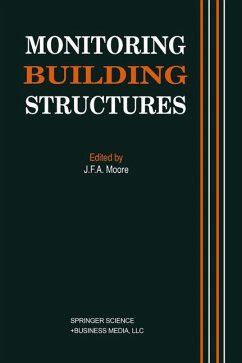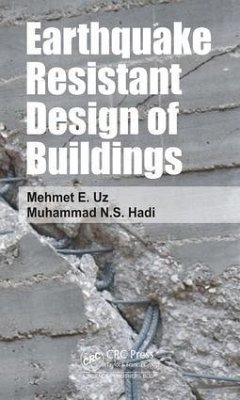
Building Engineering and Systems Design

PAYBACK Punkte
46 °P sammeln!
1. New Directions in Building Design.- 1.1. Change from Master Builders to Managers.- 1.2. Basic Traditional Building Procedure.- 1.3. Systems Design Approach to Building.- 1.4. Design by Building Team.- 2. Basic Building Elements and Their Representation.- 2.1. Main Parts of Buildings.- 2.2. Floors and Ceilings.- 2.3. Roofs.- 2.4. Exterior Walls and Openings.- 2.5. Partitions, Doors, and Interior-Wall Finishes.- 2.6. Structural Framing and Foundations.- 2.7. Plumbing.- 2.8. Heating, Ventilating, and Air Conditioning (HVAC) Systems.- 2.9. Lighting.- 2.10. Acoustics.- 2.11. Electric Supply.- 2....
1. New Directions in Building Design.- 1.1. Change from Master Builders to Managers.- 1.2. Basic Traditional Building Procedure.- 1.3. Systems Design Approach to Building.- 1.4. Design by Building Team.- 2. Basic Building Elements and Their Representation.- 2.1. Main Parts of Buildings.- 2.2. Floors and Ceilings.- 2.3. Roofs.- 2.4. Exterior Walls and Openings.- 2.5. Partitions, Doors, and Interior-Wall Finishes.- 2.6. Structural Framing and Foundations.- 2.7. Plumbing.- 2.8. Heating, Ventilating, and Air Conditioning (HVAC) Systems.- 2.9. Lighting.- 2.10. Acoustics.- 2.11. Electric Supply.- 2.12. Vertical-Circulation Elements.- 2.13. Why Drawings Are Necessary.- 2.14. Drawing Conventions.- 2.15. Types of Drawings.- 2.16. Specifications.- 2.17. Scales and Dimensions on Drawings.- 2.18. Elevation Views.- 2.19. Plan Views.- 2.20. Lines.- 2.21. Sections.- 2.22. Details.- 2.23. Survey and Plot Plans.- 3. Systems Design Method.- 3.1. Models.- 3.2. Value Measures for Comparisons 643.3. Comparisons of Systems.- 3.4. Return on Investment.- 3.5. Constraints Imposed by Building Codes.- 3.6. Zoning Codes.- 3.7. Other Constraining Regulations.- 3.8. Systems Design Steps.- 3.9. System Goals.- 3.10. System Objectives.- 3.11. System Constraints.- 3.12. Value Analysis.- 3.13. Optimum Design of Complex Systems.- 4. Application of Systems Design to Buildings.- 4.1. Considerations in Adaptation of Systems Design.- 4.2. Role of Owner.- 4.3. Conceptual Phase of Systems Design.- 4.4. Design Development Phase of Systems Design.- 5. Contract Documents and Construction Methods.- 5.1. Responsibilities Assigned by the Construction Contract.- 5.2. Components of the Contract Documents.- 5.3. Contract Drawings.- 5.4. Specifications.- 5.5. Bidding Requirements.- 5.6. Contractors Drawings.- 5.7. Construction and Occupancy Permits.- 5.8. Construction Procedures.- 6. Life Safety Concerns.- 6.1. Windstorms.- 6.2. Earthquakes.- 6.3. Fire.- 6.4. Fire Extinguishment.- 6.5. Emergency Egress.- 6.6. Fire Protection.- 6.7. Security.- 6.8. Barrier-Free Environments.- 6.9. Toxic Materials.- 6.10. Construction Safety.- 7. Building Sites and Foundations.- 7.1. Site Considerations.- 7.2. Site Surveys.- 7.3. Soil Considerations for Site and Foundation Design.- 7.4. Shallow Bearing Foundations.- 7.5. Deep Foundations.- 7.6. Lateral and Uplift Forces on Structures.- 7.7. Site Development Considerations 1917.8. Cofferdams and Foundation Walls.- 7.9. Bewatering of Excavations.- 7.10. Investigation and Testing.- 7.11. Systems-Design Approach to Site Adaptation.- 8. Structural Systems.- 8.1. Building Loads.- 8.2. Deformations of Structural Members.- 8.3. Unit Stresses and Strains.- 8.4. Idealization of Structural Materials.- 8.5. Structural Materials.- 8.6. Typical Major Constraints on Structural Systems.- 8.7. Tension Members.- 8.8. Columns.- 8.9. Trusses.- 8.10. Beams.- 8.11. Arches and Rigid Frames.- 8.12. Shells and Folded Plates.- 8.13. Cable-Supported Roofs.- 8.14. Pneumatic Structures.- 8.15. Horizontal Framing Systems.- 8.16. Vertical Structural Systems.- 8.17. Systems-Design Approach to Structural Systems.- 9. Plumbing.- 9.1. Water Supply.- 9.2. Wastewater Disposal.- 9.3. Basic Principles of Plumbing.- 9.4. Water-supply Systems.- 9.5. Sizing of Water-Supply Pipes.- 9.6. Wastewater-Removal Systems.- 9.7. Sizing of Wastewater and Vent Pipes.- 9.8. Piping for Heating Gas.- 9.9. Systems Design of Plumbing.- 10. Heating, Ventilation, and Air Conditioning.- 10.1. Design Considerations.- 10.2. Measurement of Heat.- 10.3. Heat Flow and Human Comfort.- 10.4. Thermal Insulation.- 10.5. Prevention of Damage from Condensation.- 10.6. Ventilation.- 10.7. Heat Losses.- 10.8. Heat Gains.- 10.9. Methods of Heating Buildings.- 10.10. Methods of Cooling and Air Conditioning Buildings.- 10.11. Passive Design.- 10.12. Systems-Design Approach to HVAC.- 11. Lighting.- 11.1. Accident Prevention.- 11.2. Quantity of Light.- 11.3. Quality of Light.- 11.4. Color.- 11.5. Lighting Strategies.- 11.6. Daylight.- 11.7. Lighting Equipment.- 11.8. Systems-Design Approach to Lighting.- 12. Sound and Vibration Control.- 12.1. Nature of Sounds and Vibrations.- 12.2. Measurement of Sounds.- 12.3. Acoustic Properties of Materials.- 12.4. Sound and Vibration Design Criteria.- 12.5. Sound and Vibration Control.- 12.6. Systems-Design Approach to Sound and Vibration Control.- 13. Electrical Systems.- 13.1. Characteristics of Direct Current.- 13.2. Characteristics of Alternating Current.- 13.3. Electrical Loads.- 13.4. Electrical Conductors and Raceways.- 13.5. Power-Systems Apparatus.- 13.6. Electrical Distribution in Buildings.- 13.7. Communication Systems.- 13.8. Systems-Design Approach to Electrical Distribution.- 14. Vertical Circulation.- 14.1. Ramps.- 14.2. Stairs.- 14.3. Escalators.- 14.4. Elevators.- 14.5. Dumbwaiters.- 14.6. Pneumatic Tubes and Vertical Conveyors.- 14.7. Systems-Design Approach to Vertical Circulation.- 15. Systems for Enclosing Buildings.- 15.1. Roofs.- 15.2. Roofmg.- 15.3. Exterior Walls.- 15.4. Single-Enclosure Systems.- 15.5. Windows.- 15.6. Doors in Exterior Walls.- 15.7. Systems-Design Approach to Building Enclosure.- 16. Systems for Interior Construction.- 16.1. Interior Walls and Partitions.- 16.2. Ordinary Doors.- 16.3. Special-Purpose Doors.- 16.4. Floor-Ceiling and Roof-Ceiling Systems.- 16.5. Interior Finishes.- 16.6. Systems-Design Approach to Interior Systems.- 17. Building Systems.- 17.1. Mishaps and Corrective Measures.- 17.2. Design of a Building System.- 17.3. Case-Study One: McMaster Health Sciences Center.- 17.4. Case-Study Two: Xerox International Center for Training and Management Development.- 17.5. Case-Study Three: Suburban Office Building for AT & T.- 17.6. Case-Study Four: A Glass-Enclosed Office Tower.- 17.7. Case-Study Five: An Office Building on a Tight Site.- 17.8. Case-Study Six: Office Building for Prudential Insurance Company.- 17.9. Case-Study Seven: Rowes Wharf Harbor Redevelopment Project.














